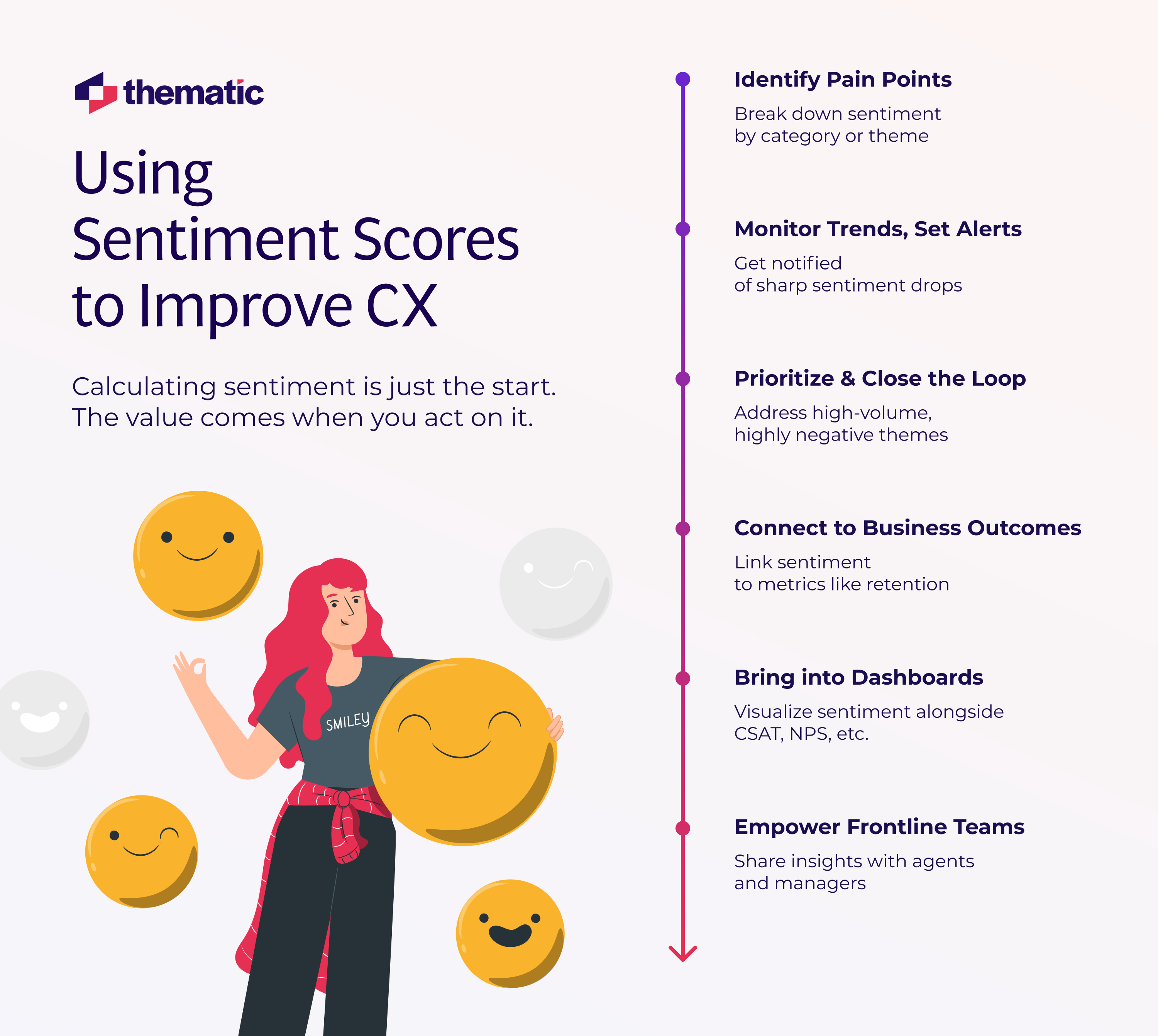
Learn what a sentiment score is, how it’s calculated, and how CX teams use it as a reliable KPI for decision-making and alerts.

When you read through customer feedback, you can often tell if the tone is positive or negative. But how do you quantify those feelings across thousands of comments?
Answer: sentiment score
Derived from sentiment analysis of customer feedback, a sentiment score gives CX and Voice of Customer (VoC) professionals a quick, quantifiable measure of customer emotion. And that matters—a lot.
In fact, one in three consumers would stop doing business with a brand they love after just one bad experience. Companies that excel at understanding and acting on customer sentiment see significantly higher growth (up to 2.5× faster revenue growth, according to Forrester).
In this article, we’ll explain
A sentiment score is a numerical rating that represents the overall sentiment or emotion expressed in a piece of text. In other words, it’s a score that tells you at a glance how positive, negative, or neutral a customer comment or review is.
This score is the output of sentiment analysis algorithms, which evaluate the words and context in feedback to determine the emotional tone. For example, an enthusiastic comment like “This product is fantastic!” would get a high positive score, while “The support was terrible” would score quite negative. Neutral statements land somewhere in the middle.
Sentiment scores are often expressed on a scale.
The idea is the same: a higher score means more positive sentiment, a lower score means more negative sentiment.
These scores can be calculated for individual pieces of text (like a single survey response) or aggregated across many comments to gauge overall sentiment, a process central to sentiment analysis of reviews or feedback. This is particularly relevant in review analysis, where transforming unstructured customer reviews into structured insights can guide product development and enhance customer experience.
In particular, review analysis offers a structured approach to interpreting customer reviews, transforming unstructured data into actionable insights that can drive product and service improvements.
Unlike a simple thumbs-up or thumbs-down, a sentiment score captures degrees of positivity or negativity. This nuance is valuable because not all positive feedback is equally enthusiastic, and not all negative feedback is equally severe.

It’s important to note that a sentiment score focuses on polarity (positive vs. negative) and intensity of emotion. It won’t tell you why customers feel that way — just how they feel.
For example, sentiment analysis might reveal customers are unhappy (low score), but you’d use thematic analysis or topic analysis to find out what they’re unhappy about (e.g. pricing, support, a specific feature). Check out our article on Thematic Analysis vs Sentiment Analysis for a deeper dive into the comparison of these two.
Still, as a metric, the sentiment score is a handy barometer of customer mood that can complement other CX metrics like CSAT or NPS. To delve deeper into the nuances of customer feedback, employing qualitative data analysis can uncover underlying themes and insights that quantitative metrics might miss.
Quantifying sentiment makes unstructured feedback actionable. Instead of just reading through comments and getting a gut feel, CX teams can track a sentiment score as a KPI. This is crucial because emotion heavily influences customer behavior. You can explore this further as we doin our guide to customer sentiment analysis.
Customers who have a positive experience are willing to spend up to 140% more than those who had a negative experience. On the flip side, a string of bad experiences can drive even loyal customers away (43% of customers have left a beloved brand after multiple poor experiences). With a number associated with a sentiment, you can measure experiences and watch for warning signs.
So, if your average sentiment score on support tickets drops sharply one week, that’s an early red flag that something’s wrong in the support experience. Without a quantified score, you might not catch that trend until the churn or complaints show up later.
In short, a sentiment score acts as an emotional pulse-check on your customer base, letting you gauge satisfaction in real time and over time.
Sentiment scores are traditionally calculated using natural language processing (NLP) algorithms that analyze text for positive, negative, or neutral cues to understand feedback or customer sentiment. There are a few approaches, ranging from simple to sophisticated:
Early sentiment analysis used dictionaries of positive and negative words. For example, words like “great” or “excellent” might add +1, while “terrible” or “poor” add –1. The system totals up the values to get a score for the text. This is straightforward but can miss context (e.g., sarcasm or negation like “not great”).
Most modern systems use AI models trained on examples of text labeled by sentiment. These models learn the nuances of language, so they can consider word context and even phrases. For instance, they’d know that “not great” is negative despite the word “great” being positive.
Traditional machine learning models (like logistic regression or SVMs) improved accuracy over simple rules by learning from large datasets of labeled feedback.
Recently, large language models (LLMs) and deep learning have revolutionized sentiment detection, enabling more nuanced and accurate analyses through AI sentiment analysis. Models like GPT-3/GPT-4 or BERT can interpret tone, context, and even sarcasm with far greater accuracy.
These AI models effectively “understand” language at a deeper level, allowing for more nuanced sentiment scoring. They can pick up on subtle cues. For example, “I guess this will do” might be classified as mildly negative despite no overtly negative words, because the model grasps the reluctant tone.
When aggregating sentiment, organizations often use a Net Sentiment Score, which is analogous to a Net Promoter Score but for sentiment. The formula commonly used is:
**Net Sentiment** = ((# of Positive mentions – # of Negative mentions) / Total mentions) × 100
This yields a score between –100 and +100.
For example,
A positive net sentiment means you have more positive than negative feedback overall, whereas a negative net sentiment indicates more negativity than positivity. This metric strips away ambiguity by boiling sentiment down to a single number.
Importantly, neutral feedback is counted in the total but doesn’t affect the net score except by influencing that percentage. Many VoC programs report net sentiment as an easy health check metric.
For instance, a net sentiment of –10 would be a serious warning sign of widespread unhappiness (more negatives than positives overall, indicating systemic issues).
On the other hand, a net sentiment of +50 would indicate a strong positive tilt in customer feelings. Companies sometimes set targets around improving net sentiment, similarly to how they set NPS targets.
It’s worth noting that sentiment score ≠ satisfaction score.
Sentiment is derived from textual feedback and reflects emotional tone, whereas something like CSAT or NPS is explicitly given by the customer in a rating scale. However, they often correlate.
In fact, some experts consider net sentiment a useful real-time complement or even an alternative to NPS, since it captures unprompted customer feelings from comments (the “voice of customer”) rather than from survey ratings.
The best practice is to use them together: sentiment analysis explains the why behind a low NPS or CSAT by analyzing the feedback comments, and gives an early indication of issues even before scores like NPS dip.
Once you have a sentiment score, how do you know if it’s “good”? Benchmarking gives context so you can track progress and spot issues early.
Calculating sentiment is just the start. The value comes when you act on it. Here's how CX and VoC teams use sentiment scores to drive impact:

A sentiment score is more than just a number; it’s your direct line to how customers feel. When paired with smart benchmarking and embedded into daily workflows, it becomes a powerful driver of CX improvement and business growth.
Whether you're tracking emotional trends, spotting red flags, or making the case for change, sentiment scores offer a scalable way to listen and respond with impact.
Ready to turn raw feedback into strategic insight? Request a demo and try Thematic on your own data.
Join the newsletter to receive the latest updates in your inbox.